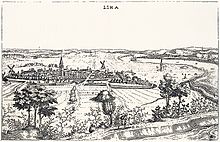Jedutenhügel

The Jedutenhügel (also Jeduten- or Jodutenberg ) is a type of monument that occurs in the districts of Friesland , Wesermarsch , Cuxhaven in Lower Saxony and in the city of Bremerhaven . The time of origin and the function of these artificially raised hills, which can reach heights of up to 6 m and a diameter of up to 30 m, have not been clarified. A dune hill in front of the Doventor in Bremen, the so-called Panzenberg, also bore this name.
Interpretations
The interpretations for the hills range from places of justice to land-based sea marks to signal or alarm points, such as waiting (observation posts), from which the residents were warned of dangers. When the enemy (such as the Vikings) approached, a warning fire could be lit from this elevation, which alerted the population in a wide area. This assumption was natural because the Vikings at the time of Charlemagne the coast Butjadingen afflicted more often. In popular belief, they are also viewed as burial places. The first to deal with this type of hill in a paper from 1923 was the teacher Heinrich Lübben from Bremerhaven. Today the hills are often used as a toboggan hill . Karl Sichart stated that the term vom u. a. The so-called Jedutengeschrei "Wapent jo, dute, ..." ("Arm yourself, people, ..."), codified in the Sachsenspiegel , is the necessary condition (on the part of the prosecutor) for holding a "screaming court" against you in the act encountered culprits, but generally represented the (binding) call for the mobilization of the armed power.
history

About the age of Jedutenbergs in the Bremerhaven district Wulsdorf give pollen analysis information. Buckwheat pollen was found in soil samples from 1.7 m, 2 m and 2.6 m depth . Buckwheat was first mentioned in Lower Saxony in 1380. Tree pollen, on the other hand, could hardly be detected at all. “Since the landscape was heavily forested until around 1000 AD, the hill must have been filled up later. This is also supported by the large quantities of heather pollen detected in the samples. They indicate a heavily cleared landscape in the area. "
“Even if the embankment is 500 years younger [than previously assumed]: The original elevation was 5 m above sea level. NHN also met all the prerequisites beforehand to be used as a location for a warning beacon that was lit when Normans drove up the Weser. "
geography
Such up to 8 m high hills can be found on both sides of the Unteıweser river and in its estuary. It must be assumed that many of them have been removed over the centuries, as last happened around 1930 at Panzenberg in Ellwürden.
Jedutenhügel can be found in the following localities:
- Lehe (Bremerhaven)
- Nordenham - Grebswarden (Wesermarsch district)
- Nordenham - Volkers (Wesermarsch district)
- Schiffdorf (District of Cuxhaven)
- Schmalenfleth , today part of Brake (Wesermarsch district)
- Varel - Jeringhave , at the junction to Rotenhahn on federal road 69 there is a Frisian Jedut hill. The heaped up, steep hill lies on the highest point of a natural knoll and has a diameter of 17 m and a height of 3.5 m (Friesland district).
- Wulsdorf (Bremerhaven) , where a district is called Jedutenberg.
In the district of Ellwürden von Nordenham in the Wesermarsch district there was also a Jedutenhügel, which has since been removed.
literature
- Joachim Blankenburg, Jörg Grützmann: The Jedutenberg in Wulsdorf - a geological specialty , in: Dieter Bischop , Nicola Borger-Keweloh, Dieter Riemer (eds.): Castle and church in Wulsdorf. Bremerhaven 2014, ISBN 978-3-931771-00-3 , pp. 83-94.
- Johannes Ey: The Jedutenhügel near Volkers, Grebswarden and Schmalenfleth, Ldkr. Wesermarsch . In: Archaeological monuments between Weser and Ems . 450 452 No. 134 136. Oldenburg (Oldenburger Forschungen, NF 13; Archäologische Mitteilungen aus Nordwestdeutschland, Supplement 34 (2000)).
- Jürgen Rabbel: Jedutenberg poses a new riddle - pollen analysis proves: the embankment is 500 years younger than expected - the lookout was even lower in the Viking Age , in: Nordsee-Zeitung, May 15, 2014, page 15.
- Dieter Riemer : The Jedutenburg - the end of a legend? , in: Dieter Bischop, Nicola Borger-Keweloh, Dieter Riemer (eds.): Castle and Church in Wulsdorf. Bremerhaven 2014, ISBN 978-3-931771-00-3 , pp. 95-105.
- Karl Sichart: The riddle of the Jodutenberge. In: Bremisches Jahrbuch , Series A, Volume 39, 1940.
- Egon Stuve: The Wulsdorf Jedutenberg. Once a defensive system against the Normans . In: Men from Morgenstern , Heimatbund an Elbe and Weser estuary e. V. (Ed.): Niederdeutsches Heimatblatt . No. 743 . Nordsee-Zeitung GmbH, Bremerhaven November 2011, p. 1–2 ( digitized version [PDF; 1,2 MB ; accessed on August 3, 2020]).
Web links
- Rudi Mark 2007 on the website www.lehe.de
- City history of Wulsdorf - Jedutenberg on the Bremerhaven Tourism website